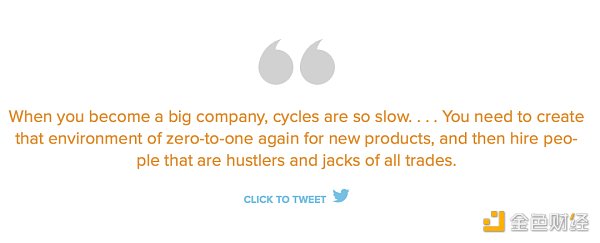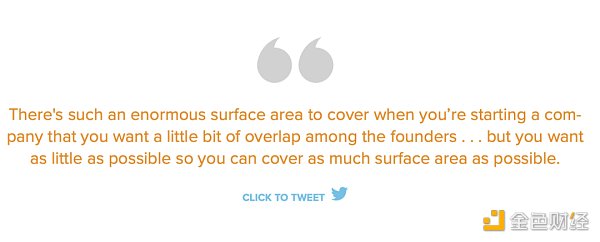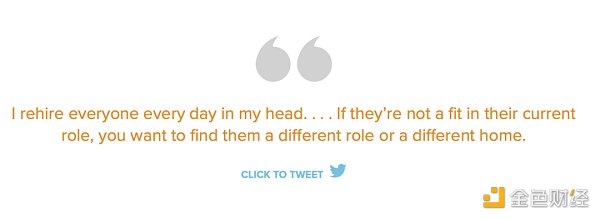a16z’s latest revelation: How successful startups attract top talent
a16z: How successful startups attract top talent.Author: Deep Thinking SenseAI
1) Based on observations of numerous founders, those who are good at going from 0 to 1 and those who are good at going from 1 to 100 differ greatly in terms of their ability models, thinking styles, management methods, and radii. In an organization driven by a stable process, reorganizing innovation often encounters significant internal friction and mismatched goal measurement, making it even more difficult than starting a business from scratch.
2) At the core, people tend to prioritize themselves, and many founders have an extreme strongman mentality, which makes it easy to find resonance and recognition in people whose model is similar to their own. However, diversity in the founder team is crucial, and leveraging the strengths and complementarities of partners requires a certain amount of weak thinking and strong trust as a foundation.
3) Hiring the right people is a skill, and sending away unsuitable people is even more of a skill. The opportunity cost of a mismatch is greater than one might imagine. The potential challenge is how to objectively evaluate employee performance and maintain sensitivity to top talent in the market.
- Aura Finance: Why choose to drive LST liquidity growth on Optimism?
- What is Web4 of the European Union? Which industries will benefit from it?
- Multi-dimensional analysis of NFT in the second quarter: Multi-chain competition intensifies outside of Ethereum, and Blur’s growth rate far outstrips its competitors.
4) A company has a distinct personal color of its founder, even if he or she is not in the limelight. In the age of AI, we see many founders endorsing products. With diverse and dense media, users have the right and interest to learn about the lively individuals behind product creation.
5) Even in the anti-globalization wave, the pace of corporate globalization is becoming more determined. People who truly understand market customs and ecology and can implement them on the ground are important anchors for rooting in the market.
a16z recently brought together a group of early-stage CEOs to discuss business secrets and learn from their peers who have successfully transitioned from fighting in the early stages of entrepreneurship to growing into large-scale growth-stage or even public companies. The event invited a series of experienced founders and leaders for interviews, where they shared their experiences and insights on running corporate companies for decades.
These interviews covered many topics, and below are some highlights on recruitment, dismissal, and expansion.
Attachment: Interviewed Companies
– Databricks: A big data processing and artificial intelligence company that provides a cloud-based data engineering and machine learning platform based on Apache Spark.
– Cloudflare: A global leader in network security and performance optimization, providing services such as content delivery networks (CDNs), firewalls, and DDoS attack protection.
– CrowdStrike: A global leader in cybersecurity, specializing in providing endpoint security solutions and threat intelligence services.
01. Ali Ghodsi, Databricks CEO

“What we’re trying to do is go back to how we did things in 2013 when the company was just starting. I think what happens now is a lot of smart people create great products, but then you go and do CEO things. And there’s nobody in the company that can actually duplicate your early actions.”
“When you become a big company, the cycles become so slow. When you hire 99% of the people as you grow are 1 in 100 or 1 in 1,000. They’re not zero to one people. So you need to create the zero to one environment again for a new product, and then hire people who can deal with all sorts of challenges and be proactive. They might do a little bit of product management, guide some code, get customer feedback and iterate quickly.“
“We try to go back and find the PhDs who created projects at Databricks. We hire them out of university and give them this mixed product and technology leadership role where they work with a small number of customers and build something for them. There’s a huge additional burden of compliance and security requirements for building any software at Databricks, so we try to free these people up as much as possible to incubate. Then we make them work very closely, make some of our customers very successful. Once we nail something for one company, we start applying it to more and more customers and then we build a product out of it.”
“Some people fail, but that’s life. If you operate lean and highly iterative, it’s acceptable.“

You have to have a lot of empathy for your employees; you can’t just be a heartless CEO. You have to always be aware of the truth, don’t lie to yourself. You have to understand what the priorities are that make the company successful and then make decisions accordingly. Sometimes, people lie to themselves or confuse priorities, like, ‘I have a co-founder who’s the COO and we’ve been good friends. If he resigns, he might take other people with him, it might have a negative impact on our culture, and it might be negative on social media.’
But you have to start from first principles: do you have an outstanding team that can win this market? If not, you have to act for the greater good of the company. For us, the right thing to do was to replace the entire executive team.
You cannot build an organization around people unless it’s the genius who created the entire product and is still responsible for everything. For everyone else, you have to make the right choices for the company in the long term.
02. Matthew Prince, Cloudflare CEO

Before Cloudflare, I founded a company with two other people. When I was looking for co-founders, I looked for people I trusted, people I would be willing to spend time with socially. So I did actually start the company with two high school buddies. We were all a little nerdy, we all had technical backgrounds, we all had legal backgrounds, we were all about the same age, and we all grew up around each other. We were always arguing about who was really responsible. Because at the end of the day, we could all do each other’s jobs. If you drew a Venn diagram, all of our circles completely overlapped.
So when I was thinking about starting another company, the first thing I did was look for people who were socially distant from me, but who could complement me in what I was good at. Michelle and I were classmates in business school. But I joked that if she invited 40 people to her birthday party, I might not get an invite. If she invited 50 people, I might—I was in that range.
We do a really good job of dividing the world up into different parts. Our third co-founder, Lee Holloway, is a technical genius. Michelle is the one who makes sure everything runs smoothly. I’m the one who’s like P. T. Barnum saying, “We’re going that way!” When you start a company, there’s such a huge area to cover, you want the circles of the founders to overlap a little bit so you can communicate, but you want that overlap to be as small as possible so you can cover as much area as possible.
03. Michelle Zatlyn, Cloudflare COO

When you start to scale, make real revenue, and build a leadership team, one mistake founders often make is not hiring executives who are better than themselves in a specific area because they’re worried they’ll be fired. You worry that investors will say, for example, “This person is better at sales than me, maybe they’ll fire me and have that person take over.” But the reality is that hiring someone who doesn’t have complementary skills is the fastest way to be fired. What you want is executives who are better than you in these areas.
The fact is, everyone wants you to stay and be successful. Because companies led by founders perform better at that scale than those that bring in outside professional management.

“In the early days, you have to find clever ways because you can’t just pour more money into the competition. You have to find something that you do better than anyone else. As a founder, you can have personality. You should let your personality shine. For example, on our blog, everything under Matthew’s name is written by him personally. He doesn’t have a ghostwriter. He personally puts pen to paper. Our chief technology officer, who’s also the 20th employee at Cloudflare, is also a very good writer.
We have extremely high-quality technical content on our blog, which attracts other good writers to join us. They’ll ask, “Can I write a blog?” We say, “Yes, please do. The more technical and geeky, the better.” We have some amazingly talented people that we might not have been able to hire if it weren’t for having them tell their stories on our blog. Once we realized the blog was an asset, it became a self-fulfilling propellant.”
04. George Kurtz, CrowdStrike CEO

In my mind, I rehire everybody every day. It’s hard for people, including founders, to make the decision to let someone go that they’ve known for a long time. But the reality is that you have to let people go. If they’re not a good fit in their current role, you want to find a different role or a different spot for them. Or, they might be a fit when you have 100 people, but when you scale to 1,000 or 5,000, they might not be a fit anymore. So I have a simple principle, which is, based on what I know about someone today, would I hire them again to do that role today? It’s a very simple formula.”
It may sound a bit cold, but I’ve never regretted letting someone go too early. In fact, I always regret waiting too long. You really have to pay attention to whether they can adapt to the current scale and whether they are suitable for today’s situation. If not, either find them a different position within the company or give them respect and condolences when they leave.
One important lesson for me is that the people who help you get to today may not be able to help you get to tomorrow. Companies must go through different growth stages, and as the company expands, you must make some difficult choices over time.

Many companies, when they expand internationally, just send a salesperson and an engineer to a foreign city and see how it goes. But the challenge of doing so is that you don’t have enough momentum. We’ve also made some similar attempts, but later we decided, “If we’re going to enter a city, we’re going to invest heavily. We’re going to send a large number of people there to provide support and market promotion, and we need to have some influence in that field to succeed. We’re not going to enter a hundred cities.” So now our international business accounts for 30% of the company’s total business, which is similar to many large companies, but we hope to achieve a 50-50 ratio.
But I think one important lesson is: Don’t try to spread the power of international expansion, but focus on the key points.
The second lesson is that in other geographical markets, many people want to be the CEO, and when they arrive, they act very arrogantly. Don’t hire these people. You really need to hire people who are willing to get their hands dirty, do the work, sweep the floor, etc. Over time, they may not be the right fit, but you have to hire the right people at the right time, not like our situation, where we hired people who wanted to be the CrowdStrike emperor in Japan.
We will continue to update Blocking; if you have any questions or suggestions, please contact us!
Was this article helpful?
93 out of 132 found this helpful
Related articles
- False exit, true entry: SEGA is raising the banner in the Web3 blockchain gaming arena
- How to stake on the EigenLayer mainnet
- Aptos proposal “Gradual Upgrade of Mainnet Framework to v1.5.0” has opened for voting, which will introduce a new standard for creating replaceable assets.
- Regulatory Pressure Slows Down Capital Inflow, Ethereum’s Collateralization Rate Approaching a Key Milestone
- AlloyX: A liquidity collateral protocol based on RWA assets
- NFT lending protocol Gondi, developed by Florida Street, has completed a $5.3 million seed round of financing, led by Hack.vc and Foundation Capital.
- Injective, the pioneer of native chain order book.






